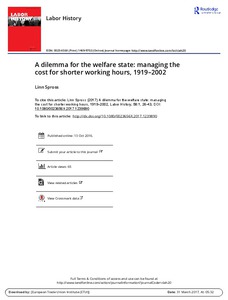A dilemma for the welfare state: managing the cost for shorter working hours, 1919–2002

2017
58
1
February
26-43
history ; labour law ; reduction of working time ; welfare state ; working time
Working time and leave
http://dx.doi.org/10.1080/0023656X.2017.1239890
English
Bibliogr.
"The purpose of this article is to study how the Swedish welfare state has managed the cost of shorter working hours. During the twentieth century, several official reports were published in order to produce knowledge about this issue and to deal with the cost for the reform. This article aims to examine the arguments and beliefs of the political economy of the welfare state that emerge from these formulations. An examination of shorter working hours as social policy sheds new light on the relationship between the welfare state and capital, in addition to limits for social policy imposed by the economic system. A reduction of work hours has never been justified as a reform that simply gives more time for leisure and less time for work, but has been assigned a cost that was necessary to manage. The reform was considered possible because it was interpreted as helping to reproduce labor power or capitalism as a whole. It was thought impossible and undesirable when considered to be a threat to this reproduction. This article shows the process of managing the cost for shorter working hours in Sweden and how arguments fundamentally changed over time, although the basic premises remained the same. "
Digital
The ETUI is co-funded by the European Union. Views and opinions expressed are however those of the author(s) only and do not necessarily reflect those of the European Union or the ETUI.